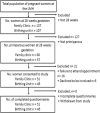The comorbidity of low back pelvic pain and risk of depression and anxiety in pregnancy in primiparous women
- PMID: 29973235
- PMCID: PMC6032543
- DOI: 10.1186/s12884-018-1929-4
The comorbidity of low back pelvic pain and risk of depression and anxiety in pregnancy in primiparous women
Abstract
Background: Approximately 50% of Australian women experience low back pain in pregnancy, with somewhere between 8 and 36% of women suffering from pregnancy related depression/anxiety. Both low back and pelvic pain and depression and anxiety are associated with poor maternal health outcomes, including increased sick leave, higher rates of functional disability, and increased access to healthcare. It also impacts upon time and mode of delivery with an increase in inductions and elective caesarean sections. For babies of women with depression and anxiety preterm birth, low birth weight and intrauterine growth restriction are all common complications. Given these poor health outcomes, it is important to determine the co-morbidity of low back and pelvic pain and depression/anxiety in pregnancy.
Methods: A cross sectional study of a hospital based sample of 96 nulliparous women were assessed at 28 weeks as part of their routine antenatal appointment. Data was collected via interview and clinical records and included the Edinburgh Depression Scale (EDS), the Numerical Rating Scale (NRS) and the Modified Oswestry Low Back Pain Disability Questionnaire (MODQ). Spearman's correlation co-efficients, prevalence ratios and ANOVA were used to determine comorbidity.
Results: 96 women consented to participation in the study. All study outcomes were moderately correlated. There were three main findings: One, there was a positive correlation between low back and pelvic girdle pain (LBPP) and depression/anxiety was rho = 0.39, p < 0.001, between LBPP and functional disability was rho = 0.51, p < 0.001 and between risk of depression/anxiety and functional disability was rho = 0.54, p < 0.001. Two, a woman with LBPP was 13 times more likely to have increased risk of depression/anxiety, whilst a woman with increased risk of depression/anxiety was 2.2 times more likely to have LBPP and finally three, amongst women who reported LBPP, the level of disability experienced was significantly higher in women who had concurrent increased risk of depression/anxiety (p = 0.003). This occurred even though the severity of pain did not differ between groups (NRS score mean p = 0.38).
Conclusions: This study found a high level of co-occurrence of LBPP, functional disability and depression/anxiety in women in their third trimester of pregnancy. Importantly women who reported higher depression/anxiety symptoms appeared to experience higher levels of functional disability in relation to their LBPP, than women with lower depression/anxiety symptoms and LBPP.
Keywords: Anxiety; Depression; Low back pain; Pelvic pain; Pregnancy.
Conflict of interest statement
Ethics approval and consent to participate
Ethics approval was received from the Ethics of Human Research Committee Lyell McEwin Hospital and Queen Elizabeth Hospital on 18/8/2009 (Ethics Number 2009132) and the University of South Australia Divisional Human Research Ethics Committee – Division of Health Sciences on 15/9/2009 (ethics number HS15–2009). All participants were provided information sheets and participants provided informed, written consent prior to any data collection.
Consent for publication
Not applicable.
Competing interests
All the authors advise that there was no potential conflict of interest during this research article.
Publisher’s Note
Springer Nature remains neutral with regard to jurisdictional claims in published maps and institutional affiliations.
References
MeSH terms
LinkOut - more resources
Full Text Sources
Other Literature Sources
Medical


